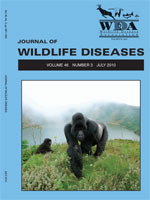Five outbreaks of botulism in waterbirds were encountered over a 5-yr period from 2004 to 2008 in Korea. In October 2008, an outbreak of avian type C botulism affected approximately 2,000 wild waterbirds in the Namdong flood control basin, Incheon, South Korea. Ecologic conditions, clinical signs exhibited by moribund birds, and lack of gross pathology and microbial evidence of infectious disease, suggested botulinum intoxication. Type C botulinum toxin was demonstrated in duck sera, liquid culture of intestinal tissue, and an extract of maggots taken from the carcasses. Additionally, 34 of 40 (85.0%) sediment samples from the same area were positive for botulinum toxin by mouse bioassay using multivalent (types A–F) antiserum, indicating that toxigenic Clostridium botulinum was present in the environment. This is the most severe case of avian botulism documented in Korea.
How to translate text using browser tools
1 July 2010
An Outbreak of Type C Botulism in Waterbirds: Incheon, Korea
Na-Ri Shin,
Seong hwan Byun,
Jeong Hoon Chun,
Jeong Hwa Shin,
Yun Jeong Kim,
Jeong-Hee Kim,
Gi-eun Rhie,
Hyen Mi Chung,
In-Pil Mo,
Cheon-Kwon Yoo
ACCESS THE FULL ARTICLE

Journal of Wildlife Diseases
Vol. 46 • No. 3
July 2010
Vol. 46 • No. 3
July 2010
Korea
outbreak
type C botulism
waterbirds




